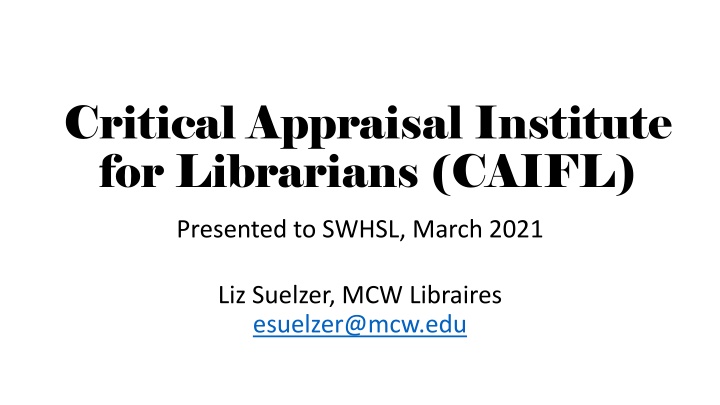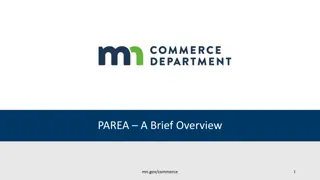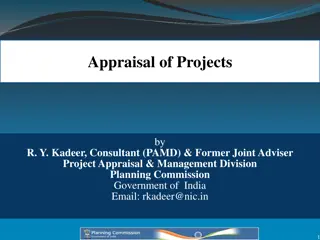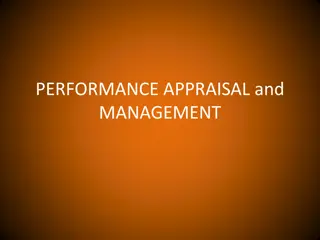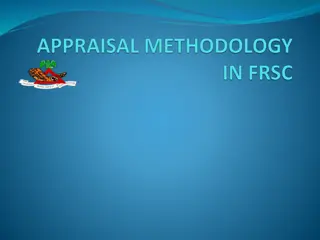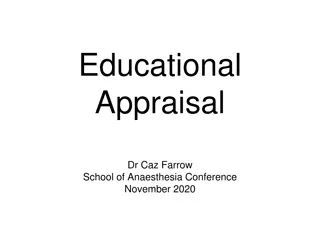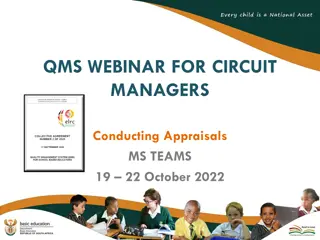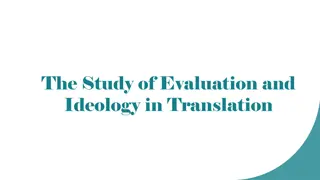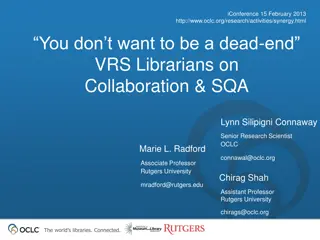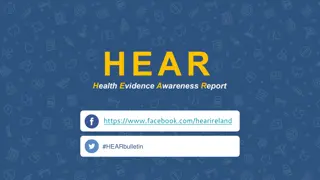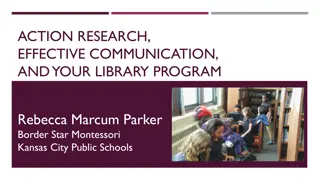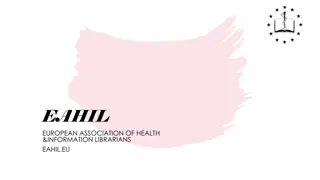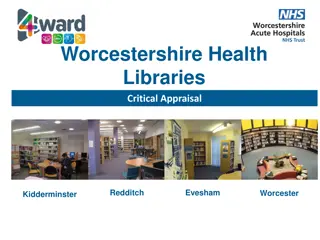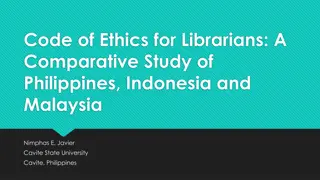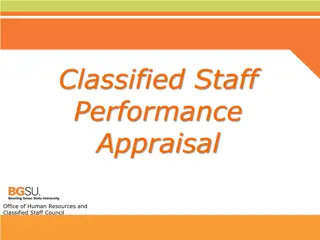Critical Appraisal Institute for Librarians (CAIFL) Overview and Objectives
CAIFL is a program designed to enhance librarian skills in critical appraisal, research design, biomedical statistics, and clinical reasoning. The goal is to improve the ability to teach these concepts to target populations. The program includes plenary sessions, educational presentations, journal club presentations, and small group sessions. Topics covered range from understanding odds ratios and risk ratios to critiquing biostatistical concepts and appraising biomedical articles.
Download Presentation

Please find below an Image/Link to download the presentation.
The content on the website is provided AS IS for your information and personal use only. It may not be sold, licensed, or shared on other websites without obtaining consent from the author.If you encounter any issues during the download, it is possible that the publisher has removed the file from their server.
You are allowed to download the files provided on this website for personal or commercial use, subject to the condition that they are used lawfully. All files are the property of their respective owners.
The content on the website is provided AS IS for your information and personal use only. It may not be sold, licensed, or shared on other websites without obtaining consent from the author.
E N D
Presentation Transcript
Critical Appraisal Institute for Librarians (CAIFL) Presented to SWHSL, March 2021 Liz Suelzer, MCW Libraires esuelzer@mcw.edu
Todays Presentation Overview of CAIFL Understanding Odds Ratios & Risk Ratios
CAIL Goal & Objectives To develop librarian s critical appraisal skills including enhanced understanding of research design, biomedical statistics, and clinical reasoning to apply knowledge in teaching target populations. 1. Describe and analyze study methodologies used in clinical research. 2. Define and critique biostatistical concepts used to report the results of clinical research studies. 3. Critically appraise biomedical articles including an understanding of the methodology, sources of bias, and the results. 4. Teach critical appraisal with confidence.
CAIFL Content & Classes 2 plenary sessions lead by clinical faculty Focus on what medical students need to know about critical appraisal 6 weekly sessions 2 hour sessions 2-4 hours of homework videos, articles, readings, worksheets 1 educational presentation 1 journal club presentation
Plenary Session 1: Why EBM? Andy Coyle, MD Okay, that sounds great, but 1. I ll naturally learn the right ways to diagnose and manage my patients as I proceed through my training. 2. I ll learn EBM from other practicing physicians who are knowledgeable about this sort of stuff. 3. I ll read the primary literature. And I ll know the studies are well done and can be trusted since they got published in a peer-reviewed medical journal. 4. I ll only read stuff from the most reputable journals with the highest impact factors. 5. I ll rely on others to aggregate the data for me. Uptodate and Dynamed have tons of great evidence-based information available. 6. I ll just read everything relevant to my field. I signed up for eTOC from the journals relevant to my field and will read those as they come into my email inbox. EBM / Critical Appraisal is an essential SKILL for a practicing clinician one that you need to be able to turn on for critical decisions 5
CAIFL - Details Sponsored by the New York Medical College January 26 March 16, 2021 Fully online course 35 MLA CE credits $450 fee Thank you SWHSL! 6 librarian instructors, 2 clinical instructors Small group sessions, 9-10 librarians/session
CAIFL Topics Week 1: Critical Appraisal & Clinical Study Designs Basics & Biases Week 2: Foundational Stats: Descriptive & Inferential Statistics, Hypothesis Testing, Confounding, causation, confidence intervals, p values Week 3: Common Measures of Association in Biomedical Studies: Harm & Therapy Studies, Odds ratio, risk ratio, relative risk, absolute risk reduction Week 4: Appraising Diagnostic Tool and Screening Studies, Sensitivity, specificity, likelihood ratios, predictive values Week 5: Prognosis Studies and Systematic Reviews, Survival charts, forest plot, funnel plot Week 6: Journal Club
Odds Ratio | Relative Risk Liz Suelzer, MCW Libraires esuelzer@mcw.edu
Odds Ratio Risk Ratio/Relative Risk A measure of how strongly an event is associated with exposure. Ratio of the risk of an event in the two groups Odds: probability of occurrence of an event/probability of the event not occurring Risk: chance of the outcome of interest/all possible outcomes A / (A + B) C / (C + D) (A / C) (B / D) OR = 1: no difference in event & exposure RR = 1: no difference in outcome & exposure OR < 1: lower odds of association between the exposure and outcome. Exposure us protective. RR < 1: risk of the outcome is decreased by the exposure. Favors intervention/exposure. OR > 1: higher odds of association between the exposure and outcome. Exposure is harmful. RR > 1: risk of the outcome is increased by the exposure. Favors control.
Odds Risk/Probability 4 4 6 4 = .4 4 = .67 196.02 10 200
2 x 2 Table Event/ Disease/ Outcome No Event/ No Disease/ No Outcome Total Participants Treatment/ Experimental/ Exposed Group A B (A + B) Control/ Placebo/ C D (C + D) Unexposed Group (A + C) (B + D) Total Outcomes
Case Control Cohort
Case Control Start w/ Outcome Look for Exposure Time
Case Control Odds Ratio (A / C) (B / D) Start w/ Outcome Sick Odds of drinking tea & getting sick: 5 / 5 = 1 5 3 Tea Odds of drinking tea & not sick: 3 / 7 = .42 5 7 Totals 10 10 Odds Ratio 1 / .42 = 2.33 Look for Exposure Time
Cohort Start w/ Exposure Look for Outcome Time
Cohort A / (A + B) C / (C + D) Risk Ratio Start w/ Exposure Risk of getting sick after tea 2 / 10= .2 Sick Totals 2 8 10 Tea Risk of getting sick & not drinking tea: 6 / 10 = .6 6 4 10 2/10 6/10 = .33 Look for Outcome Time
Varenicline for smoking cessation in people with schizophrenia: a double blind randomized pilot study. Relative Risk Relapsed Abstained 1 / (1 + 3) N=4 Varenicline = .75 4 / (4 + 0) N=4 Placebo Weiner E, Buchholz A, Coffay A, Liu F, McMahon RP, Buchanan RW, Kelly DL. Varenicline for smoking cessation in people with schizophrenia: a double blind randomized pilot study. Schizophr Res. 2011 Jun;129(1):94-5. doi: 10.1016/j.schres.2011.02.003. Epub 2011 Mar 4. PMID: 21376537; PMCID: PMC3691956.
Increased Breast Cancer Risk among Women Who Work Predominantly at Night Breast Cancer N=6281 Night work N=6024 Day work Odds Ratio 434 / 5847 434 * 5723 = 1.41 301 / 5723 301 * 5847 Hansen J. Increased breast cancer risk among women who work predominantly at night. Epidemiology. 2001 Jan;12(1):74-7. doi: 10.1097/00001648-200101000-00013. PMID: 11138824.
Sources consulted: https://www.ncbi.nlm.nih.gov/pmc/articles/PMC4640017/ https://www.youtube.com/watch?v=hOtoV2Kjb0o https://www.ncbi.nlm.nih.gov/books/NBK430824 https://www.ncbi.nlm.nih.gov/books/NBK431098/
